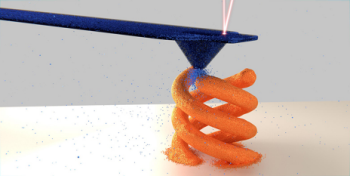Jan 22 2016
A group of researchers at ETH Zurich have developed an advanced 3D microprinting method, that can be utilized to develop small, intricate, overhanging metal structures in just one simple step. This latest technique holds potential for designing a wide range of microtools, such as tools for keyhole surgeries and complicated components for watches.
 ETH researchers use a movable micropipette (blue) to manufacture tiny copper objects. (Visualization: ETH Zurich / Alain Reiser)
ETH researchers use a movable micropipette (blue) to manufacture tiny copper objects. (Visualization: ETH Zurich / Alain Reiser)
The current 3D microprinting processes can be used to develop such overhanging structures, although a number of complicated steps are involved. A stencil is developed in advance and used to serve as a placeholder within the overhang that has to be printed. When printing is over, the template should be taken off. In the latest method the print head is also capable of printing sideways, meaning templates are not necessary to print the overhangs.
Luca Hirt, a doctoral student at ETH’s Laboratory of Biosensors and Bioelectronics, has developed the innovative method. The process is a modification of the FluidFM system that was developed at ETH Zurich. A moveable micropipette, which forms the core of the FluidFM system, is mounted on a leaf spring and can be positioned in an accurate way. Today this system is being used in medicine and biological research to infuse substances into separate cells, for cell analysis, etc. The ETH spin-off, Cytosurge, have been marketing the FluidFM is system for three years.
Hirt has been investigating the use of FluidFM system for printing processes, as part of his thesis at ETH Zurich. He was interested in utilizing this method to deposit dissolved metals on to a highly conductive substrate. The basic mechanism of the system involves the use of a liquid droplet, placed on a gold base plate. The micropipette’s tip enters the droplet and serves as a print head, a solution of copper sulfate then gradually flows via the pipette. An electrode is used to apply an electric charge between the substrate and the droplet, promoting a chemical reaction within the opening of the pipette. After emerging from the pipette aperture, the copper sulfate solution reacts to form solid copper. The copper is then deposited onto the base plate as a small 3D object. The movement of the pipette is controlled by a computer, and the 3D objects can be printed layer by layer and pixel by pixel. The process’ spatial resolution relies on the size of the aperture in the micropipette, and this aperture establishes the size of the 3D copper deposits.
It is now possible to create 3D pixels with a diameters span from 800 nm to over 5 µm, and they can be combined to form larger-sized 3D objects. Different and unique microscopic objects have been developed in a feasibility study, including pure and non-porous copper objects that were mechanically stable. This was confirmed by studies carried out by researchers, headed by ETH Zurich Professor of Nanometallurgy, Ralph Spolenak. One remarkable object included three nested microspirals that were developed by the ETH scientists. All of this was achieved in a single step, without the use of a template.
This method can be used to print not only copper but also other metals.
Tomaso Zambelli, Associate Lecturer, ETH Zurich’s Laboratory of Biosensors and Bioelectronics.
The FluidFM system can be used for 3D printing with composite materials and polymers. The technique offers one major benefit over other standard 3D microprinting processes: By deflecting the leaf spring, the forces acting upon the pipette’s tip can be determined easily. This leaf spring is mounted with the micropipette.
We can use this signal as feedback. Unlike other 3D printing systems, ours can detect which areas of the object have already been printed.
Luca Hirt, Doctoral Student, ETH Zurich's Laboratory of Biosensors and Bioelectronics
This way, the entire printing process can be easily automated.
A patent application for the technique has been submitted by the ETH researchers. As of now, the method has been licensed by Cytosurge. Pascal Behr has immensely contributed towards developing the FluidFM system. He is now the CEO of Cytosurge.
We see big market potential in the printing process and an opportunity to further diversify our company. We are convinced of the idea of using FluidFM in 3D microprinting. Now, the task is to optimise this application in collaboration with interested researchers at universities and in industry – for example, in the watchmaking, medical technology and automotive sectors.
Pascal Behr, CEO, Cytosurge
According to Behr, the new method could prove useful in rapid prototyping, where 3D printing can be used to develop microtools in a fast and efficient way.
“It is a case of mutual give and take, from which both sides profit,” said Zambelli.
ETH Zurich will continue to collaborate with Cytosurge. As part of this partnership, Cytosurge will supply its latest systems to ETH who would then use this equipment in subsequent studies. The aim of these studies is to test the devices and ultimately develop them for different types of applications.